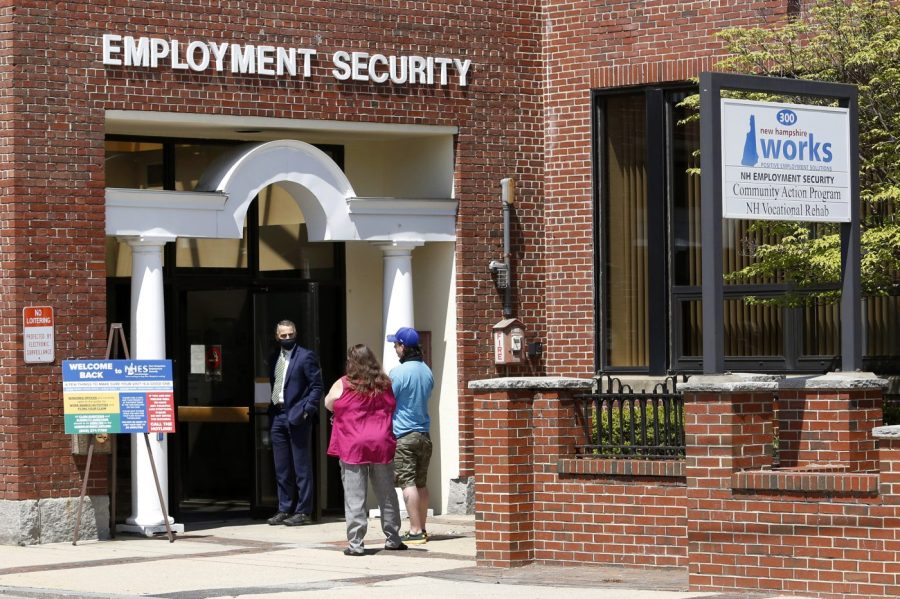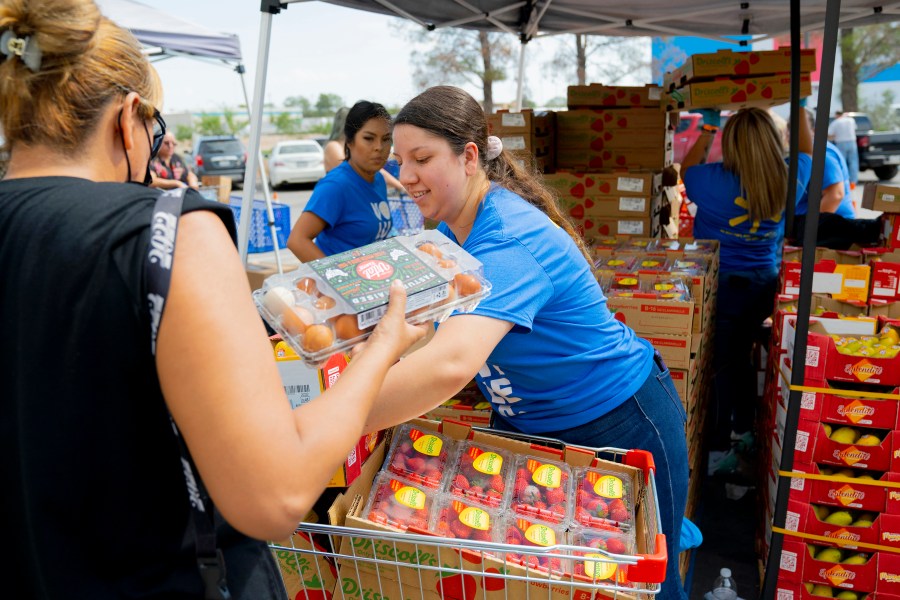Recession already here for many Americans as buying power, credit, social net shrinks
The stock market may be closely watching the chance of an official economic recession, but many Americans across the country are already feeling the squeeze as they contend with higher prices and borrowing costs than they saw a year ago.
While Evelyn Canela, 31, a senior program director at a nonprofit based in Harlem, said she thinks she has a “well-paying job,” which paid in the $100,000 range when she started, she also said she’s been feeling the pressure to save, particularly as various industries have seen more layoffs in recent months.
In a poll released by Morning Consult last month, almost half of respondents believed the nation was already in a recession.
The poll also found about 41 percent of Americans surveyed had begun taking precautions and steps to beef up savings, but a closer look at the data revealed disparities by income.
Adults in households with annual earnings above $100,000 were more likely than others to say they were beginning to prepare for an economic downturn or recession, with 52 percent saying they’d taken to stockpiling goods or food, cut back on spending or other steps.
By contrast, the poll found that those in households that earned under $50,000 annually were more likely to say they had not yet begun to make preparations “but wish they could.”
The poll comes as recent months have seen more Americans feeling poorer and pessimistic about the nation’s economic forecast at a time when rising price stickers are putting a squeeze on pockets across the spectrum.

At the same time, data shows credit card debt is also on the rise; a March study from Wallethub found “credit card debt increased by $85.8 billion during Q4 2022 — the highest quarterly increase ever recorded.”
Job losses are cutting into spending power, even for six-figure earners
Recent months have also seen big layoffs, particularly in the tech industry as high-profile companies like Google, Apple and Amazon have announced plans to cut jobs. Other businesses like Goldman Sachs have also unveiled plans for thousands of layoffs this year.
“I’ve always been saving, but I’ve been way more aggressive more recently. I’m not in the tech field, but I’ve seen these massive layoffs,” Canela said. “It’s a very scary thing when people in your close circle have lost their jobs.”
Research has shown more consumers making more than $100,000 annually say they’re living paycheck to paycheck.
A survey conducted by PYMNTS and LendingClub found that more than half of consumers in the income bracket reported the same in December 2022.
Social program cutbacks and inflation are squeezing Americans
At the same time, experts say the most vulnerable populations are bearing the brunt of the financial pain in current conditions.
Kyle Waide, president and CEO of the Atlanta Community Food Bank, said in a recent interview that the organization is seeing “40 percent more people today than we did at the beginning of 2022.”
“We are distributing essentially the same volume of food as we did during the height of the pandemic,” he said. “And we know that increase in demand in the community relates to increased costs associated with inflation, along with the discontinuation of various pandemic-era stimulus programs.”
Waide said he’s referring to the expiration of the temporary expansion to the Child Tax Credit that millions received during the pandemic, as well as the discontinuation of the emergency Supplemental Nutrition Assistance Program (SNAP) allocations, among other pandemic-era programs that have begun to unwind.
Anti-hunger advocates have said it’s also been getting tougher for some food banks to meet demand in the face of higher food prices.
“We’re operating on a deficit budget right now,” said Valerie Stone Hawthorne, director of government relations at the North Texas Food Bank. “We are currently working on a budget of $66 million, but we’re only forecasting $45 million in public support.”
“We’ve planned for that to operate in this deficit budget, but it’s not sustainable,” she said, adding, “I don’t see how removing benefits that people need is going to solve the hunger problem.”

Increase in homelessness and food insecurity looks likely
Hawthorne’s comments come amid increased concern over what proposed cuts to nondefense spending on Capitol Hill could mean for efforts to combat food insecurity and homelessness amid a looming battle over the debt limit.
In recent months, House Republicans have ramped up calls for significant fiscal reform and spending cuts to be made as part of a larger deal later this year to act on the debt limit, which caps how much money the Treasury can owe to cover the nation’s bills.
The Treasury first began implementing what it called “extraordinary measures” in January to buy time until the nation reaches the so-called “X Date,” when it could risk a national default.
Among the proposals that have gained in the House GOP conference in recent months include pitches for tougher work requirements for welfare programs, as well as cap limits for discretionary spending for nondefense programs at dollar levels not seen since 2022 amid a larger push by the party to combat inflation.
“What we’re ultimately talking about is cutting staff benefits with one of the most cruel policies that there is,” Christina Wong, director of public policy and advocacy for the Northwest Harvest food justice group, said of proposed changes to work requirements for SNAP.
“Lots of evidence that shows that work requirements don’t actually get people to work because it’s not a lack of willingness to find work, but we’re talking about a population with deep structural barriers to finding employment,” she said.
Carl Gershenson, a lab director at Eviction Lab, said such moves would be “felt immediately,” as housing advocates and officials sound alarms over how federal efforts like the Housing Choice Voucher Program would fare with such cuts.
“That’s families losing access to the support when they need it most and increasing the wait time for people who have already been waiting in some cases up to a decade,” Gershenson said.
Staying in your home is becoming more difficult
In a 2022 report, the left-leaning Center on Budget and Policy Priorities found that only about 25 percent of households eligible for federal rental assistance receive it due to “funding limitations” — shutting out more than 16 million households.
“Unlike some other kinds of programs, like Social Security, where everybody’s eligible to help for the housing programs that the federal government has, there’s a lot of people who are eligible who don’t get to help just because it’s discretionary funding program,” said Steve Berg, chief policy officer at National Alliance to End Homelessness, in an interview.
“Congress puts as much money on the table as sort of fits in with the other needs they have that year,” Berg said, adding “people get help get help and the people that don’t get help are homeless.”
House GOP leadership has signaled the conference will move on its own with a debt ceiling bill if Democrats don’t come to the bargaining table, vowing fiscal discipline as the national debt teeters around $31.4 trillion.
But they face a significant challenge in unifying behind a plan that can win the support of their slim majority in the lower chamber as well as the public — recent polling shows Americans agree little on areas to draw down spending.
“The very first thing they need to do is to walk in their constituents’ shoes,” said Barbara Jackson, a retired database administrator based in Atlanta. Lawmakers should “take about six months to have to balance the budget with what [their constituents are] making,” Jackson added.
“The far majority of politicians today are at the upper echelon of the income. So they can’t relate to the everyday John and Joe,” Jackson said.

Inflation isn’t falling fast enough to help most Americans
Inflation may be slowing some, but Americans say they aren’t feeling much relief as they contend with higher prices than they saw a year ago.
And some are fearful the worst is yet to come.
“I think we’re moving toward a recession,” Canela said. “At least that’s what it feels like.”
Earlier this month, the Labor Department reported that annual consumer inflation in March reached its lowest point in nearly two years, as the Federal Reserve has continued to hike interest rates in a bid to counter rising prices.
A key driver behind the decline was the slowdown in grocery prices: Annual food costs saw a 1.5 percent drop from February and an overall 5 percent decrease from the high watermark seen in August.
But despite the drop, some can’t help but notice the price stickers are much more north of where they used to be.
Jackson, 74, said she sees “more aspects of high inflation every day.“
“One of the first things I noticed, probably like millions of others, is the cost of food,” she said. “Not too long ago, you could buy three pounds of onion for a couple of dollars. Now, it’s five bucks.”
While Jackson, who recalled the era of the 2008 financial crisis, said there’s “definitely a difference” between current conditions and a recession, she also said there is still some pressure.
“It’s almost like this is a mist as opposed to a fire and that it’s insidious,” Jackson said. “It’s just everywhere and little by little you begin to notice it.”
It’s not technically a recession, but it sure feels like one for many
There is consensus among experts that the country is not currently experiencing a recession, but that doesn’t mean there isn’t a downturn on the horizon.
U.S. central bankers broached the issue of a potential recession following the collapses of two prominent banks last month, minutes of the Federal Open Market Committee meeting show.
“Given their assessment of the potential economic effects of the recent banking-sector developments, the staff’s projection at the time of the March meeting included a mild recession starting later this year,” the minutes stated.
Officials also expect to hike interest rates one more time this year, which can lead to higher mortgages and credit card payments, as the Fed seeks to make it more expensive to borrow to tackle inflation.
Even so, Fed officials are torn over whether to do so at the bank’s next policy meeting in May.
Sylvan Lane contributed.
Copyright 2023 Nexstar Media Inc. All rights reserved. This material may not be published, broadcast, rewritten, or redistributed. Regular the hill posts









